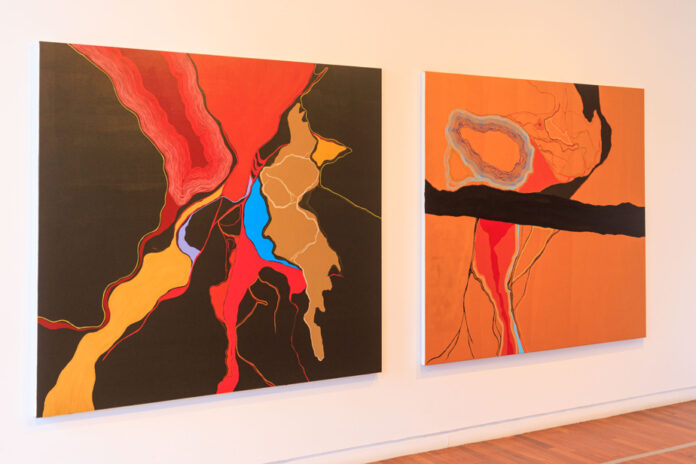The Phi Foundation invites us, in August, to explore the lines of thought of Moridja Kitenge Banza, Amélie Brisson-Darveau and Pavitra Wickramasinghe. And to discover a work on public art. A rich program that evokes our responsibilities towards the Earth, our personal and also common heritage. With themes ranging from identity to memory and racism…
It’s rather rare that the Phi Foundation gratifies us, like that, in the middle of summer, with a solid program intended for those who want to reactivate their neurons when we would tend to leave them fallow! Two exhibitions and a series of activities around public art will easily furnish a day’s visit to Phi as the substance is nourishing.
The main course of this summer feast is the deployment – on the four floors of 451, rue Saint-Jean – of the works of Moridja Kitenge Banza. Remember that Moridja, born in the Democratic Republic of Congo, has lived in Montreal for more than 10 years and has exhibited there many times, notably in the galleries of Joyce Yahouda and Hugues Charbonneau, the latter currently representing him.
Moridja, through his life journey, is fascinated by memory, identity, culture and geopolitics. Raw materials of his approach that he embodies in painting, installation, photography or video. From his exhibition Living in the imaginary at Phi, two unpublished works stand out.
First, two sets of paintings, a new part of his Palmistry series. One, “African”, is colorful and has soft ocher tones reminiscent of the hues of laterites. The other, “Quebecois”, in black and white, reveals his attraction for the dark spots on a white background of Borduas or the Icebergs of Riopelle.
These paintings are critical explorations of territories. The territory of the lines of the hand, when palmistry sees character traits there. And the geographical territory revealed by photos taken by Moridja in Congo or by satellites. Landscapes. Mapping of mining sites. Strong paintings that explore identity, history and those raw materials of humanity that are colonialism and what results from it, for example the exploitation of resources by foreign conglomerates.
The other flagship corpus is on the third floor. Moridja set up his “business” Cycle there. An installation about a fictional society that makes a profit from recycling a raw material: racism. A work on the roots and the reality of racism. The visitor becomes a customer of Cycle, “the first to have found how to recycle racism”, says the artist whose idea results from a racist act of which he was the victim in 2018.
“Racism is something that comes up all the time, so I wanted to think about it,” he said. I’ve wanted to talk about recycling for a long time and explore the idea of who benefits from an act of racism. I thought to myself that racism is like a raw material that exists in nature. »
The installation equates the idea of racism, its cost and the profits made by those who exploit this “matter of racism” that Moridja has embodied. You can, in fact, see copies (kinds of black rocks) in a window. The artist explains that this raw material was “created” (to justify slavery and colonization) by the French politician Arthur de Gobineau (1816-1882), author of an Essay on the Inequality of Human Races . And that racism has since been refined. He thus exposes the “refined matter of racism”, a white ingot that evokes gold and the commercialization of what is considered to be of value. A brilliant and, of course, awkward analogy.
Throughout the visit, you can also hear the echoes of the Hymn to us on the stairs, a video and sound work that Moridja, a tenor by profession, created in 2009 and which reflects the facets of his identity and the influences that shaped it. A work tied to Beethoven’s Ode to Joy, chosen by the European Union to symbolize peace and solidarity.
At 465, rue Saint-Jean, Phi also presents, until September 3, Les contours de l’oublie, an exhibition curated by Daniel Fiset and imagined by Amélie Brisson-Darveau and Pavitra Wickramasinghe. A one-year project with secondary 3 students from Lucien-Pagé school, around the theme of gentrification and the memory of the former industrial building at 6528-6574, rue Waverly. An artistic and social approach, with the production of ceramic tiles and charcoal smears to testify to the particularities of the architecture of this building occupied by offices and artists’ studios.
Also at 465 rue Saint-Jean, curator Victoria Carrasco has developed a series of events titled Remembering, Performing, Forgetting: Connecting Space Through Utopia, which questions the role of public art, our desire to occupying public space and our tendency to overlook the significance of past artistic expressions. The project includes lectures and two programs of film screenings, including videos by Jacques Giraldeau, Jean Palardy, Kerstin Honeit, Rodolfo Andaur and the Society of Affective Archives. Food for thought which will be presented from August 16 to 27. Good visit !

